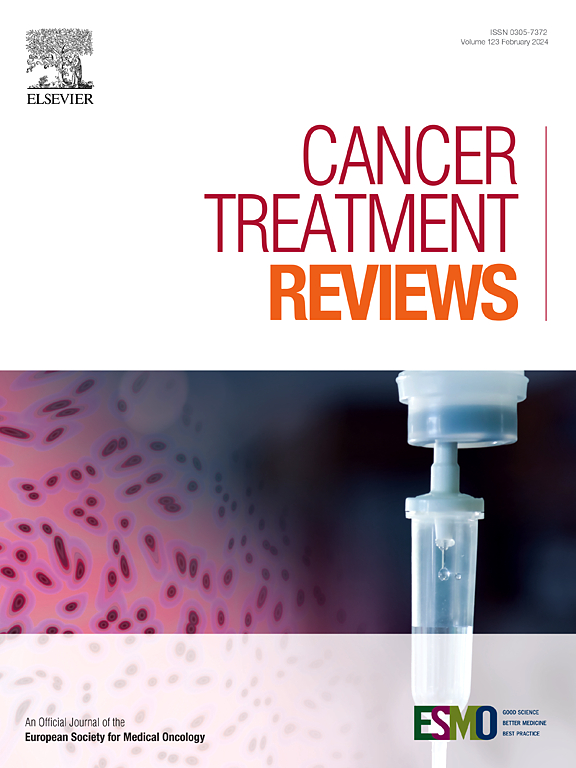肿瘤治疗的静脉注射与皮下注射的系统文献综述:临床,经济和患者的观点
IF 10.5
1区 医学
Q1 ONCOLOGY
引用次数: 0
摘要
皮下(SC)制剂的肿瘤治疗提供了一个潜在的更节省时间和更方便的替代静脉(IV)给药。然而,有必要从更广泛的角度探索SC相对IV给药的潜在益处,以了解其更大规模的影响。在本系统文献综述(SLR)中,我们评估了SC/IV肿瘤治疗的疗效、药代动力学/药效学(PK/PD)、安全性、患者和医疗保健提供者(HCP)偏好,以及患者结局、成本和时间要求的差异。SLR于2019年1月进行,并于2023年5月更新,包括169份出版物。研究提供了静脉注射和皮下注射制剂在临床、经济和患者预后方面的比较结果。重点是抗癌治疗,IV和SC制剂正在开发3期临床试验,或已获得监管部门批准。SC管理与HCP时间和患者主持时间的节省有关。还观察到直接和间接的费用节约。据报道,SC管理提高了治疗满意度和患者/HCP偏好,同时也提高了护理人员的工作效率。SC和IV制剂对肿瘤药物的相对耐受性相似;然而,据报道,注射部位反应的发生率较高。IV和SC给药的总生存期、PK/PD和总有效率结果具有可比性。该SLR表明,皮下注射和静脉注射具有相当的疗效、PK/PD和耐受性,皮下注射与节省成本和时间有关,通常是患者和HCPs的首选。因此,肿瘤治疗的SC给药可能比IV给药有优势。本文章由计算机程序翻译,如有差异,请以英文原文为准。

Systematic literature review of intravenous versus subcutaneous administration of oncology therapies: A clinical, economic and patient perspective
Subcutaneous (SC) formulations of oncology therapies offer a potentially less time-consuming and more convenient alternative to intravenous (IV) administration. However, exploring the potential benefits of SC over IV administration from a broader perspective is necessary to understand the larger-scale impact. In this systematic literature review (SLR), we evaluated the efficacy, pharmacokinetics/pharmacodynamics (PK/PD), safety, and patient and healthcare provider (HCP) preference for SC/IV oncology therapies, along with differences in patient outcomes, costs, and time requirements. The SLR was conducted in January 2019 and updated in May 2023, and included 169 publications. Studies providing comparative results between IV and SC formulations regarding clinical, economic, and patient outcomes were included. The focus was anticancer therapies for which both IV and SC formulations are being developed in phase 3 clinical trials, or are regulatory approved. SC administration was associated with savings in HCP time and patient chair time. Direct and indirect cost-savings were also observed. Increased treatment satisfaction and patient/HCP preference was reported with SC administration, as was improved caregiver productivity. The relative tolerability of SC and IV formulations for oncology drugs was similar; however, a higher incidence of injection-site reactions was reported with SC administration. Overall survival, PK/PD, and overall response rate results were comparable between IV and SC administration. This SLR demonstrates that SC and IV administration had comparable efficacy, PK/PD, and tolerability profiles, with SC administration associated with cost and time savings, and generally preferred by patients and HCPs. Therefore, SC administration of oncology therapies may offer advantages over IV administration.
求助全文
通过发布文献求助,成功后即可免费获取论文全文。
去求助
来源期刊

Cancer treatment reviews
医学-肿瘤学
CiteScore
21.40
自引率
0.80%
发文量
109
审稿时长
13 days
期刊介绍:
Cancer Treatment Reviews
Journal Overview:
International journal focused on developments in cancer treatment research
Publishes state-of-the-art, authoritative reviews to keep clinicians and researchers informed
Regular Sections in Each Issue:
Comments on Controversy
Tumor Reviews
Anti-tumor Treatments
New Drugs
Complications of Treatment
General and Supportive Care
Laboratory/Clinic Interface
Submission and Editorial System:
Online submission and editorial system for Cancer Treatment Reviews
 求助内容:
求助内容: 应助结果提醒方式:
应助结果提醒方式:


